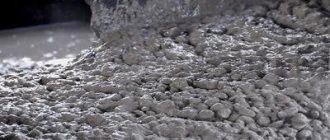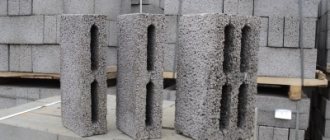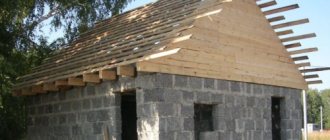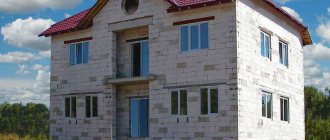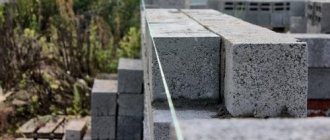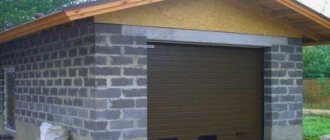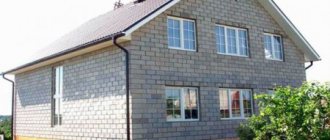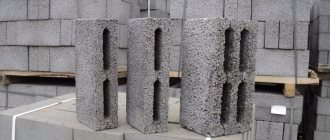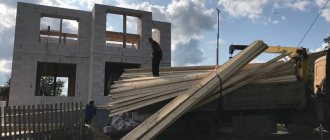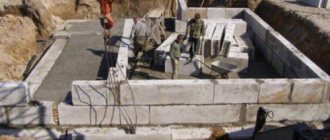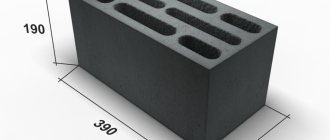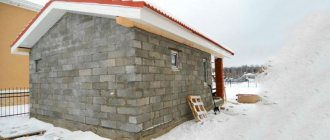It is easy to use and fits well into the masonry. To know the properties and features of this material, it is necessary to study its composition.
You can prepare a solution for the production of stone with your own hands.
What does expanded clay block consist of?
A high-quality expanded clay block consists of components that have previously passed certification. This is Portland cement of a certain brand, expanded clay fractions, fine sand dispersion, and also water are needed. In this case, Portland cement acts as a binder. All ingredients have requirements that must also be observed when making the stone yourself.
The composition of expanded clay concrete blocks is described in this video:
Binding components
Portland cement is used as a binding ingredient . For expanded clay blocks, it must have certain characteristics and comply with GOST 10178-85:
- brand not lower than M400;
- cement may be without additives or may have mineral additives;
- the tensile strength of cement in bending must be at least 5.4 (55) MPa (kgf/cm);
- the compressive strength should not be less than 39.2 (400) MPa (kgf/cm);
- The beginning of setting should occur no earlier than 45 minutes after preparation.
The more Portland cement you add to the stone, the stronger it will be. If you use low-grade material, the volumetric weight of the finished block will decrease. Because of this, it is recommended to use Portland cement of a grade no lower than M400.
Water
Requirements for the quality of water for the solution are agreed upon in the document GOST 23732-79, which defines the standards and acceptable characteristics of the liquid for concrete.
It says here that water should not contain impurities , but if they do exist, then their amount should not exceed 10 mg/liter.
The solution water should not contain petroleum products, fats or oils. Also, there should be no coloring impurities.
It is best to use tap water at room temperature; it should not be hot or very cold. It is prohibited to use water from lakes and seas for the composition.
Also, the water must contain a certain amount of soluble salts, ions and suspended particles. Standard indicators are determined by taking a sample and conducting an examination of the liquid . The oxidation of water should not be more than 15 mg per liter.
Expanded clay and sand
Sand and expanded clay are considered fillers for expanded clay concrete stone. There are also several requirements for their quality. For example, some manufacturers use coarse or medium sand to create a good frame for the future block. It is better to use expanded clay in a small dispersion. The ideal fraction size is from 5 to 10 mm: this adds strength to the block.
Reference ! Requirements for expanded clay are determined by the standards from the document GOST 9757-90, which indicates its recommended density and weight.
How to calculate the amount of material?
Correct calculation of materials is an important point in construction. Unused materials will be difficult to sell, only at a large discount, which will require costs.
First, house designs are selected. Manufacturers produce standard sizes of expanded clay concrete:
- for external walls 190 * 190 * 360 mm;
- for internal partitions 190 * 90 (120) * 360 mm.
It is necessary to add up the areas of all the walls, taking into account the masonry parameters. Subtract the total area of doorways and windows.
Common mistakes when calculating materials for construction:
- When calculating, they often forget to include gables.
- It is necessary to take into account the internal walls when laying from KBB.
- When installing an armored belt, it must be subtracted from the height of the walls.
- When externally facing with brick, expanded clay concrete walls are built slightly smaller than the outer wall.
Often the height of KBB walls is a multiple of the height of block elements with a seam (0.2 m). This means that without an armored belt, the height of the walls will be a multiple of (2.4, 2.6, 2.8).
Component proportions
If all the requirements for the components are met, then there will be no problems with preparing the solution. The main thing is to maintain proportions and not let the mass harden too quickly. Some manufacturers improve the composition of the mixture by adding special plasticizers to it. They make the mixture more pliable for pouring and also prevent it from hardening right away.
When making expanded clay blocks, the following proportions of components are used::
- 1 part Portland cement;
- 2-3 parts sand;
- 0.9-1 part water;
- 5-6 parts of expanded clay.
Everything is mixed in a certain order and only then poured into molds for the block. For example, to produce 1 cubic meter of expanded clay concrete you will need 430 kg of M400 Portland cement, 510 kg of expanded clay, 420 kg of sand and 140 kg of water. If you add less sand and cement, the specific gravity of the finished mixture will decrease. If it is necessary to make a lighter mixture for pouring, then reduce the amount of cement, remove the sand, and increase the proportion of expanded clay.
Special Applications
Floor
The composition of expanded clay concrete for flooring is a common question among many people involved in construction. Expanded clay concrete includes several components, which may differ depending on the purpose of use. So the floor mixture will include:
- Cement minimum M500.
- Water;
- Sand;
- Expanded clay.
For floor screed, expanded clay gravel is the best choice. Moreover, by 0.5-0.6 cubic meters. m of expanded clay should account for 1.4-1.5 tons of a mixture of sand and cement. For a clearer example, the proportion looks like:
- 1 tsp cement;
- 1 tsp water;
- 3 hours sand;
- 2 hours of expanded clay.
We’ll talk about the composition of expanded clay concrete for walls further.
This video will tell you how such a screed is made from expanded clay concrete:
Walls
To build walls made of expanded clay concrete, you can use the following proportion to prepare the mixture:
- 1 part cement grade 400;
- 1.5 parts of expanded clay sand (fractions up to 5 mm);
- 1 tsp fine expanded clay;
Walls built from this material are effectively used in low-rise construction.
Next, the composition of expanded clay concrete for flooring is subject to consideration.
Floors
For the construction of expanded clay concrete floors, you can use M400 cement. In this case, the composition of the mixture will be in the following proportions:
- 1 tsp cement;
- 3-4 hours of sand;
- 4-5 hours of expanded clay;
- 1.5 tsp water;
- Plasticizer according to instructions.
Depending on what proportion to adhere to, the final result, the strength of the material and its brand will depend. When using expanded clay of large fractions, a solution with low strength is obtained. It can be used as a thermal insulation material. The use of fine fractions makes it possible to create durable expanded clay concrete, which can be used in the construction of walls and load-bearing structures.
The following video will tell you about the composition of expanded clay concrete for flooring and the production of the mixture for it:
Step-by-step instructions for preparing the mixture
At first glance, mixing the components does not cause problems, but if you do it in the wrong sequence, you can achieve a consistency that is not suitable for pouring a mold. It may be too liquid, or, conversely, too thick. Then the finished block will not meet the requirements of GOST. To avoid mistakes, you can follow the instructions :
Sand and cement are poured into a concrete mixer. The dry mixture is mixed, you can initially mix it in a trough and pour it into the equipment container.- Add water and stir well again. The consistency should be medium thick.
- At the final stage, expanded clay is added. It is poured in gradually. During this step, the concrete mixer may begin to work more slowly as aggregate is added to the mixture.
When it becomes clear that the mixture has already been mixed, you need to check its consistency . It is desirable that there are no bubbles in its composition. If necessary, plasticizers and other impurities are added to improve the properties of the solution.
Glue
The proportions of the dry part and water are indicated on the label, usually 1 standard bag is diluted with 5 liters of liquid, the optimal consistency is the thickness of fatty sour cream. The thoroughly mixed substance is allowed to brew for 15 minutes, then it is applied to slightly moistened blocks. Leveling should be done within 10 minutes, after the composition becomes too viscous, it dries completely in 6 hours.
For 1 sq. m of wall you will need, on average, 25 kg of glue. It is advisable to use the finished bundle within 4 hours, stirring occasionally to prevent separation.
Preparation of glue for laying aerated concrete blocks
The importance of correct selection of ingredients and proportions
If you select the ingredients incorrectly and do not follow the proportions for preparing the mixture, the resulting product will be a building material that does not meet the standards. It will be unsuitable for building walls, and if construction does begin, the finished house will not last long.
Manufacturers always choose only those components that are certified and comply with GOST standards. Only such material is able to withstand all the loads in the masonry, and also has the properties inherent in high-quality expanded clay blocks.
Features of masonry
Such blocks are much larger than ordinary bricks, which allows not only to speed up the construction process, but also to save on cement glue. To lay 1 m² of wall you will need about 35 kg of dry adhesive mixture.
In the openings it is necessary to lay a corner, on each side there should be a support about 10 cm wide. After laying the mortar, in order for an even fit to occur, it is rubbed with the upper side.
There must be a solution at the end, which is necessary to form a vertical seam. The laying method is the same as for ordinary bricks, the block is just a little larger in size.
In order to strengthen the structure, you can strengthen the walls every three rows with reinforcement. In order for the building to be level, the masonry process must be controlled using a building level and a plumb line.
Compact the solution
Since expanded clay has a large number of air pores, it is lighter than the concrete composition and will float to the surface, making the blocks uneven, therefore, at the very beginning of hardening, expanded clay must be compacted inside the block. According to GOST, expanded clay blocks must first be subjected to vibration pressing using a special machine, and then dried in an oven. At home, the machine can be replaced with similar movements of a shovel, and then tamped with a wooden block until “cement milk” appears on the surface. The top of the block in the mold can be leveled using a trowel.
Advantages of expanded clay blocks in comparison with alternative materials.
- Environmental Safety . Expanded clay concrete is made from natural materials (cement, sand, clay), which ensures its high environmental friendliness. The material has been assigned the first radiation safety class. It fully complies with modern sanitary and hygienic requirements in terms of sound insulation and vapor permeability.
- The thermal conductivity of expanded clay concrete and the use of hollow blocks in construction make houses made of this material warm.
- The low specific gravity of expanded clay blocks allows you to save on foundation construction and transportation.
- The dimensions and weight of the blocks reduce the cost of labor and cement mortar during the construction of walls and speed up construction.
- Low hydroscopicity and, as a consequence, high frost resistance increase the service life of structures made of expanded clay blocks and make it possible to save on wall protection.
- The use of blocks with through voids makes it possible to construct load-bearing frames inside the walls, increasing the load-bearing capacity of structures.
- Low shrinkage values provide savings on cosmetic repairs.
Making expanded clay concrete with your own hands
The technology for manufacturing expanded clay concrete mass is so simple that one person can handle it without the help of others. Tools and materials required for the production of expanded clay concrete:
- concrete mixer with a volume exceeding 130 liters;
- containers for mixing components;
- shovel, preferably a shovel;
- expanded clay grain of various fractions (depending on the purpose of using concrete);
- cement M-400;
- sand (river);
- pure water.
To make blocks you will need molds and a trowel.
Equipment for the production of
To produce expanded clay concrete blocks (manually) you need:
- concrete mixer;
- several shovels;
- machine with vibrator;
- several forms.
A concrete mixer can be purchased or rented. Machine tools are also sold, although they are not the cheapest equipment. You can make them yourself, and if you are a good welder, then one machine will require one day of assembly. There are a huge number of machine designs. These are mainly frame units, with forms installed and rigidly fixed inside. A vibrator operating from a 220-volt network is also rigidly attached to the frame. The device is sold in construction stores.
Another option is a vibrating table, which is a horizontal plane. It is usually installed on springs, and a vibrator is attached to it. For the machine you will have to make several molds with your own hands. And the larger the table area, the more molds can fit on it, the higher the productivity of homemade equipment.
Important! Do not overdo it, because the vibrator has a certain power, which is enough to vibrate a certain mass.
Vibrating machine for two blocks
Mold for expanded clay concrete blocks
To make molds, various flat materials are used: sheet iron with a thickness of at least 2 mm, boards, plywood, OSB boards, etc. The main task of the work manufacturer is to adjust the dimensions of the mold to the dimensions of the block: 190x188x390 mm (standard load-bearing wall block). There are so-called semi-blocks (used for the construction of partitions), dimensions: 90x188x390.
Standard sizes of expanded clay concrete blocks
One of the features of expanded clay concrete blocks is the voids, which lighten the stone without reducing the load-bearing capacity, reduce costs by reducing the volume of the mixture used, and increase the thermal properties of the product. Therefore, during manufacturing, three pipes with a diameter of 40-50 mm are rigidly installed in the molds, located at the same distance from each other and the walls of the mold.
The pipes are connected to each other by welding with horizontal bridges (reinforcement, angle or steel strip). They are attached to the walls of the mold by electric welding if the mold is made of steel sheet, or using self-tapping screws if wooden products are used.
Ready-made forms of various types
Characteristics.
3.1. Strength.
Expanded clay block strength values:
- thermal insulation - 5-25 kg/cm2;
- structural and thermal insulation – 35 – 100 kg/cm2;
- structural - 100 - 500 kg/cm2.
3.2. Volume weight.
Volumetric weight of expanded clay blocks:
- thermal insulation - 350-600 kg/m 3;
- structural and thermal insulation - 600 - 1400 kg/m 3;
- structural - 1400 - 1800 kg/m 3.
3.3. Thermal conductivity.
The thermal conductivity of expanded clay blocks is 0.14-0.66 W/(m*K). Thermal conductivity increases with increasing cement content. According to this indicator, the thermal insulation blocks are at the level of wood. Even structural ones are preferable to concrete and brick. The use of hollow blocks in construction reduces the thermal conductivity of walls and makes the house warmer.
3.4. Frost resistance.
Frost resistance increases with decreasing porosity. The minimum values (15 - 50 cycles) are for thermal insulating expanded clay blocks. For structural and thermal insulation - up to 150 cycles, for structural ones - up to 500.
3.5. Shrinkage.
Shrinkage of expanded clay blocks is at the level of heavy concrete - 0.3-0.5 mm/m.
3.6. Water absorption.
Water absorption of expanded clay blocks is 5 - 10% by weight. The value can be reduced by adding complex additives and plasticizers to the expanded clay concrete mixture.
3.7. Vapor permeability.
The vapor permeability of expanded clay blocks is 0.3-0.9 mg/(m*h*Pa). The value increases with increasing porosity and degree of hollowness. For heat-insulating blocks the values are maximum, for structural blocks they are minimum.
3.8. Fire resistance.
The fire resistance limit of expanded clay blocks is 180 minutes at a temperature of 1050 C.
3.9. Price.
The cost of expanded clay blocks depends on the degree of hollowness, on strength, determined by the cement content, and is in the range of 2200-3500 rubles/m3.
3.10. Soundproofing.
The sound insulation properties of expanded clay blocks improve with increasing porosity. A partition made of heat-insulating blocks with dimensions of 590x90x188 mm provides sound insulation at a level of 45-50 dB.
3.11. Maximum number of storeys in a building.
Structural expanded clay blocks allow for high-rise construction. It is possible to build 12-story buildings
Table 2: Characteristics of expanded clay blocks
| Indicator name | Meaning | A comment |
| Strength, kg/cm2 | 5-500 | The minimum strength values are for light heat-insulating blocks, the maximum are for the heaviest structural blocks |
| Volumetric weight, kg/m3 | 350 -1800 | With an increase in the percentage of cement content in the expanded clay concrete mixture, the volumetric weight and strength will increase |
| Thermal conductivity, W/m*K | 0,14 – 0,66 | The indicator is better than that of brick and concrete; worsens with increasing % of cement content. |
| Frost resistance, cycles | 15-500 | The minimum values are for light heat-insulating blocks, the maximum values are for the heaviest structural blocks. |
| Shrinkage, mm/m | 0,3 — 0,5 | Good indicator at the level of heavy concrete |
| Water absorption,% | 5-10 | A good indicator that can be improved by the use of complex additives and plasticizers |
| Vapor permeability, mg/(m*h*Pa) | 0,3-.0,9 | High value in comparison with other building materials; increases with increasing porosity and degree of hollowness of blocks |
| Fire resistance, min. at a temperature of 1050 C | 180 | Value higher than other lightweight concretes |
| Cost RUB/m3 | 2200-3500 | Depends on the cement content in the mixture and the degree of hollowness |
| Sound insulation, dB | 45-50 | Value for a partition made of heat-insulating blocks with dimensions 590x90x188 mm; the indicator increases with increasing expanded clay content |
| Maximum number of storeys of a building, floors | 12 | Achieved by using structural blocks |
Roof insulation with expanded clay
The roof serves to protect buildings and structures from atmospheric influences and acts as a thermal insulation barrier from cold and heat.
The temperature in the room depends on how correctly the roof insulation is carried out. There are many types of materials for roof insulation. Let's consider roof insulation with expanded clay over the coating.
Expanded clay is a natural material obtained by firing certain types of clay. This is a round-shaped material with a porous structure, inert, light in weight, frost-resistant, fire-resistant, resistant to temperature changes, rotting, and fungus formation.
The more porous the expanded clay, the higher its thermal insulation properties. Expanded clay comes in different fractions, which determines its size. This is a lightweight, inexpensive, durable material that will perfectly insulate your roof covering.
Roofs are divided into
- pitched (slope more than 10 degrees)
- flat slope (slope from 1 to 10 degrees)
- flat (slope up to 2 degrees)
The insulation of expanded clay coverings for any roof structure is carried out using the same technology. The “pie” looks like this:
- The coating is provided with a vapor barrier;
- We carry out insulation with expanded clay;
- We perform a cement screed;
Now let’s look at the differences in further roof insulation
- If the roof is flat, sloping, then the next step is to apply a primer and a waterproofing carpet.
- If the roof is pitched (tent), then the roof slopes are covered from the materials you have chosen. Insulation under the roofing is carried out with heat-insulating materials (mineral slab, insulating mats, etc.) protected by anti-condensation film.
We looked at options for insulating different roof structures. Let's take a closer look at the process of insulating a roof with expanded clay over a coating. The minimum thickness of the insulation is determined by thermal engineering calculations.
Gypsum plaster
The main advantage of gypsum plaster mixtures over cement-sand mixtures is that they are somewhat lighter and provide slightly higher thermal insulation. If you pre-treat the walls with concrete contact, their adhesion will improve.
However, some specialists do without pre-treatment, applying plaster directly to the surface. As practice shows, a high-quality mixture sets well and adheres without any problems even to an unprepared wall, especially since a number of plasters already contain concrete contact. The wall dries quickly, practically without absorbing the plaster, the layer remains beautiful and even.
Preparation of formwork
Use thin steel sheets and wood for making. You will need a pencil, tape measure, and hand saw. Consider the dimensions of expanded clay concrete blocks. We advise you to focus on the dimensions of a standard cinder block and brick. It is preferable to reproduce the geometry of the brick, but for a large building it is more convenient to use an increased size corresponding to the cinder block.
Formwork for pouring 48 expanded clay blocks at a time
The main stages of form construction:
- Mark the blanks of the required sizes.
- Cut out the necessary parts.
- Prepare L-shaped side elements.
- Connect the workpiece elements using steel angles.
- Nail a thin sheet of metal to the base and sides of the formwork.
If sheet material is not available, use machine oil to coat the inside to ensure a tight seal.
